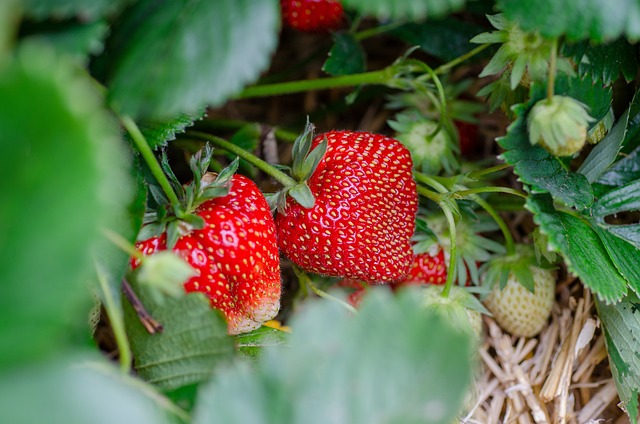We all know that the weather can impact our plans. A rainy day might ruin a picnic, while a heatwave makes us crave some ice cream. But did you know the weather can also influence the taste of the food? Weather patterns play a surprising role in shaping the flavor profile of our fruits, vegetables, and even beverages. In this blog post, we are going to explore weather and food flavor, specifically the impact of weather on taste.
Sunlight and Food Taste
Sunshine isn’t just about warmth; it’s a key ingredient in the taste factory of nature. Here’s how sunlight influences the food taste:
Sugar Production
Think of sun-drenched strawberries bursting with sweetness compared to their paler, shade-grown counterparts. How does the sunshine affect the taste of strawberries? Sunlight fuels photosynthesis, the process by which plants convert sunlight, water, and carbon dioxide into sugars. More sunlight means more sugar production, resulting in sweeter fruits and vegetables.
 Image by Katharina N. from Pixabay
Image by Katharina N. from Pixabay
Acidity
The balance between sweetness and acidity is crucial for a complex flavor profile. Sunlight exposure can impact acidity levels in fruits. For instance, grapes grown in regions with long sunny days tend to have a higher sugar content and lower acidity, leading to sweeter wines.
Flavor Compounds
Sunlight also influences the production of volatile organic compounds (VOCs) – the aromatic molecules responsible for a fruit or vegetable’s distinctive aroma and flavor. Think of the intense, grassy notes of sun-ripened tomatoes compared to the milder taste of those grown in cooler conditions.
Rainfall and Flavor Profile
While excessive rain can be detrimental to crops, a healthy dose of precipitation plays a vital role in taste. Rainwater helps plants absorb essential nutrients from the soil, which can translate into a more robust flavor profile. Think of the rich, earthy taste of mushrooms that have thrived after a good downpour.
Rainfall plays a critical role in the science behind coffee bean flavor development. While excessive rain can lead to problems like mold and fungus, a moderate amount of precipitation during the growing season can actually enhance the taste.
A gentle increase in rainfall during a specific period can introduce mild stress on the plant. This controlled stress can, in turn, trigger the production of more complex flavor compounds in the beans. This is the magic behind the monsooned Malabar coffee beans from India.
 Image source: Karachun, CC BY-SA 4.0, via Wikimedia Commons
Image source: Karachun, CC BY-SA 4.0, via Wikimedia Commons
These beans are specifically harvested during the monsoon season, where they are exposed to increased humidity and rainfall. The exposure to moisture plumps the beans and washes away some of the bitterness, resulting in coffee with a smooth, earthy body and subtle spicy notes. This demonstrates how farmers can harness weather patterns to cultivate unique flavor profiles prized by coffee lovers around the world.
Temperature Effects on Flavor
Temperature fluctuations throughout the growing season significantly impact food flavor. Warmer temperatures can speed up the ripening process, leading to sweeter fruits with a softer texture. This explains why summer fruits like peaches and melons are typically more intensely sweet than their fall counterparts.
Conversely, cool nights during the growing season can help fruits retain their acidity. This is why grapes grown in regions with cool nights often produce wines with a refreshing balance of sweetness and acidity.
 Photo by Tim Mossholder on Unsplash
Photo by Tim Mossholder on Unsplash
Extreme temperatures, both hot and cold, can stress plants, leading to changes in food taste. For instance, prolonged heat waves can make vegetables like lettuce bitter.
Weather’s Influence on Indirect Factors
Weather impact on food taste extends beyond direct sunlight, rain, and temperature:
- Pest and disease control. Weather patterns can influence the prevalence of pests and diseases that can damage crops. A mild winter might allow pests to survive, leading to tasteless fruits and vegetables with blemishes.
- Pollination. Weather plays a role in pollinator activity. Cold, wet weather can hinder bee activity, potentially affecting the fruit set and ultimately, the taste of the final product.
Climate and Food Taste
Climate change poses a threat to the delicate balance of factors that influence taste. Rising temperatures, erratic rainfall patterns, and increased extreme weather events can all disrupt the way crops grow, potentially leading to:
- Reduced food flavor intensity. Climate change could result in fruits and vegetables with lower sugar content and less intense flavors.
- Shifting flavor profiles. Warmer temperatures might favor the production of certain flavor compounds over others, potentially altering the taste of familiar foods.
- Reduced nutritional value. Changes in weather patterns could also impact the nutritional profile of crops, leading to fruits and vegetables with lower levels of vitamins and minerals.
The Takeaway
Now you know about the close connection between weather patterns and flavor. Understanding how weather shapes the taste of our food allows us to appreciate the seasonal variations in flavor. It also highlights the importance of sustainable farming practices that promote healthy ecosystems and resilient crops.






